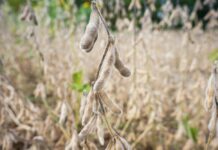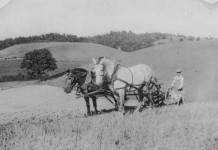It has been a rather soggy start to the planting season this year. The U.S. Department of Agriculture National Agricultural Statistics Service monitors weekly crop planting progress and conditions for each state.
According to the May 19 planting report for Ohio (release.nass.usda.gov) approximately 34% of the corn crop has been planted throughout the state. Looking at previous data for the same time of year (the third week of May) we are currently behind the five-year average of 48% of corn planted.
In northeast Ohio, we have fared slightly better than the rest of the state, where I estimate we have planted 50 to 60% of corn here in Trumbull County. We still have a lot of unplanted acres, and because the priority is on corn, soybeans will continue to be on the backburner.
Planting delays have caused some farmers to draw comparisons to the 2019 growing season when most of Ohio’s corn crop was planted after June 1. Planting in 2019 was challenging, to put it mildly, and we are in a much better situation this year regarding planting progress. The persistent rains in May 2019 prevented many farmers from getting in the fields, but surprisingly the total rainfall for that month was near normal or only slightly above normal. In contrast, this May we have experienced above average rainfall across Ohio, with some areas receiving more than twice their normal rainfall, according to the Midwest Regional Climate Center (mrcc.purdue.edu).
With June rapidly approaching, some farmers may be looking to hit the planting panic button. While delayed planting can reduce overall corn yield, the planting date is just one of many factors that can help or hurt yield. Historically, planting date has not had a strong influence on corn yield in Ohio. However, factors such as rainfall and temperature during pollination have influenced yield more significantly.
If you are in an area that was affected by the drought last year, you are acutely aware of how much yield is impacted by a lack of water during pollination. If the weather turns favorable soon and we dry out a bit you can put the panic button back in the closet.
Another yield-limiting factor to consider this spring is nitrogen loss. Early applications of nitrogen are at increased risk of leaching, especially in fields that experience heavy rainfall events like the weather patterns at the end of April. It can be difficult to monitor nitrogen losses in the soil, but frequent monitoring of crop conditions throughout the season can help you evaluate crop needs.
Outright nitrogen deficiencies can be readily detected by pale green or yellow leaves, but nitrogen levels slightly below optimum can be a little more difficult to diagnose.
In-season tissue testing is a great way to determine what nutrients are in your plants and can help you adjust early season nitrogen applications accordingly. A simple tissue test is less than $50 (often much cheaper) and can tell you how your crop is managing nutrients, so you know whether you need to apply nitrogen or not. With tight margins this year, you don’t want to apply spend any more on fertilizer than necessary.
Finally, another consideration for this wet spring is the effectiveness of your herbicide program. Herbicides vary in their water solubility, and how well they stick to soil particles (adsorption).
Generally, high water solubility and low soil adsorption will result in the greatest risk of leaching from the soils.
For example, metribuzin will be more likely to leach in heavy rainfall conditions compared to atrazine. Atrazine is less water soluble, and it has a greater adsorption to the soil.
If you want to learn more about how your herbicides are holding up in this rain you can find more information from the University of Nebraska at go.osu.edu/rainandherbicides.













